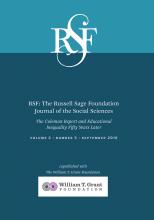Research Article
Open Access
School Segregation and Racial Academic Achievement Gaps
Sean F. Reardon
RSF: The Russell Sage Foundation Journal of the Social Sciences September 2016, 2 (5) 34-57; DOI: https://doi.org/10.7758/RSF.2016.2.5.03
Sean F. Reardon
aEndowed professor of poverty and inequality in education at Stanford University

REFERENCES
- ↵
- Bischoff, Kendra
- ↵
- Borman, Geoffrey D., and
- Maritza Dowling
- ↵Burdick-Will, Julia, Jens Ludwig, Stephen W. Raudenbush, Robert J. Sampson, Lisa Sanbonmatsu, and Patrick Sharkey. 2011. “Converging Evidence for Neighborhood Effects on Children’s Test Scores: An Experimental, Quasi-Experimental, and Observational Comparison.” In Whither Opportunity? Rising Inequality and the Uncertain Life Chances of Low-Income Children, edited by Greg J. Duncan and Richard J. Murnane. New York: Russell Sage Foundation.
- ↵
- Card, David, and
- Jesse Rothstein
- ↵
- ↵
- ↵
- Clark, Kenneth B., and
- Mamie K. Clark
- ↵
- ↵Coleman, James S., Ernest Q. Campbell, Carol J. Hobson, James McPartland, Alexander M. Mood, Frederick D. Weinfeld, and Robert L. York. 1966. Equality of Educational Opportunity. Washington: U.S. Department of Health, Education, and Welfare, Office of Education.
- ↵
- ↵Hanushek, Eric A., and Steven G. Rivkin. 2007. “School Quality and the Black-White Achievement Gap.” Working Paper 12651. Cambridge, Mass.: National Bureau of Economic Research.
- ↵
- Ho, Andrew D., and
- Sean F. Reardon
- ↵Johnson, Rucker C. 2011. “Long-Run Impacts of School Desegregation and School Quality on Adult Attainments.” Working Paper 16664. Cambridge, Mass.: National Bureau of Economic Research.
- ↵Kahlenberg, Richard D. 2006. “A New Way on School Integration.” New York: The Century Foundation.
- ↵Kozol, Jonathan. 1991. Savage Inequalities: Children in America’s Schools. New York: Crown.
- ↵
- Lankford, Hamilton,
- Susanna Loeb, and
- James Wycoff
- ↵Logan, John R. 2011. “Separate and Unequal: The Neighborhood Gap for Blacks, Hispanics, and Asians in Metropolitan America.” US2010 Project: Brown University and Russell Sage Foundation. Providence, R.I.: Brown University.
- ↵Page, Scott E. 2008. The Difference: How the Power of Diversity Creates Better Groups, Firms, Schools, and Societies. Princeton, N.J.: Princeton University Press.
- ↵Pattillo, Mary. 2013. Black Picket Fences: Privilege and Peril Among the Black Middle Class. Chicago: University of Chicago Press.
- ↵
- Pettigrew, Thomas F., and
- Linda R. Tropp
- ↵
- ↵
- ↵Reardon, Sean F., and Lori Rhodes. 2011. “The Effects of Socioeconomic School Integration Policies on Racial School Segregation.” in Integrating Schools in a Changing Society, edited by Erica Frankenberg and Elizabeth DeBray. Chapel Hill: University of North Carolina Press.
- ↵
- Reardon, Sean F., and
- John T. Yun
- ↵
- Reardon, Sean F.,
- John T. Yun, , and
- Tamela McNulty Eitle
- ↵
- Reardon, Sean F.,
- John T. Yun, , and
- Michal Kurlaender
- ↵
- Sampson, Robert J.,
- Patrick Sharkey, , and
- Stephen W. Raudenbush
- ↵
- Saporito, Salvatore, and
- Deneesh Sohoni
- ↵
- Saporito, Salvatore, and
- Deneesh Sohoni
- ↵
- Sharkey, Patrick
- ↵
- ↵
- ↵
- Wodtke, Geoffrey T.,
- David J. Harding, , and
- Felix Elwert
In this issue
School Segregation and Racial Academic Achievement Gaps
Sean F. Reardon
RSF: The Russell Sage Foundation Journal of the Social Sciences Sep 2016, 2 (5) 34-57; DOI: 10.7758/RSF.2016.2.5.03





